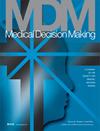在使用 EQ-5D-3L 估算健康状态效用值时捕捉估值研究取样的不确定性
IF 3.1
3区 医学
Q2 HEALTH CARE SCIENCES & SERVICES
引用次数: 0
摘要
目标与基于偏好的健康相关生活质量工具(如 EQ-5D-3L )相关的效用分数是以点估计值的形式报告的。在本研究中,我们开发了一些方法来捕捉与英国 EQ-5D-3L 估值研究相关的不确定性,这种不确定性是由基础数据固有的变异性引起的,而点估计却默认忽略了这种变异性。我们推导出一种新的费率,该费率可适当考虑这一点,并为 EQ-5D-3L 的 243 种健康状态中每种状态的效用分配一个特定的闭式分布。方法利用英国 EQ-5D-3L 估值研究,我们采用贝叶斯方法获得了推导效用分数的后验分布。我们构建了一个分层模型,该模型考虑到了模型的误设和调查参与者的反应,从而从后验值中获得马尔科夫链蒙特卡罗(MCMC)样本。后验分布由正态分布的混合物近似,以 Kullback-Leibler (KL) 分歧作为评估近似度的标准。我们考虑使用 Broyden-Fletcher-Goldfarb-Shanno (BFGS) 算法来估计混合物分布的参数。没有发现不收敛的证据。我们的模型对先验值和起始值的变化具有稳健性。EQ-5D-3L 状态的后效效用分布被总结为正态分布的 3 分量混合物,且相应的 KL 分歧值较低。要点健康技术评估指南通常要求在经济评估中考虑不确定性,但健康工具估值研究中使用的回归模型的参数不确定性往往被忽视。我们考虑了英国的 EQ-5D-3L 估值研究,构建了一个贝叶斯模型,该模型考虑了原本会被忽略的不确定性因素,并推导出封闭形式的效用分布。研究人员可在经济评估中使用推导出的费率,因为它允许分析人员直接从相应的分布中抽取效用值样本,从而反映出效用评分的相关不确定性。本文章由计算机程序翻译,如有差异,请以英文原文为准。
Capturing Valuation Study Sampling Uncertainty in the Estimation of Health State Utility Values Using the EQ-5D-3L
ObjectivesUtility scores associated with preference-based health-related quality-of-life instruments such as the EQ-5D-3L are reported as point estimates. In this study, we develop methods for capturing the uncertainty associated with the valuation study of the UK EQ-5D-3L that arises from the variability inherent in the underlying data, which is tacitly ignored by point estimates. We derive a new tariff that properly accounts for this and assigns a specific closed-form distribution to the utility of each of the 243 health states of the EQ-5D-3L.MethodsUsing the UK EQ-5D-3L valuation study, we used a Bayesian approach to obtain the posterior distributions of the derived utility scores. We constructed a hierarchical model that accounts for model misspecification and the responses of the survey participants to obtain Markov chain Monte Carlo (MCMC) samples from the posteriors. The posterior distributions were approximated by mixtures of normal distributions under the Kullback–Leibler (KL) divergence as the criterion for the assessment of the approximation. We considered the Broyden–Fletcher–Goldfarb–Shanno (BFGS) algorithm to estimate the parameters of the mixture distributions.ResultsWe derived an MCMC sample of total size 4,000 × 243. No evidence of nonconvergence was found. Our model was robust to changes in priors and starting values. The posterior utility distributions of the EQ-5D-3L states were summarized as 3-component mixtures of normal distributions, and the corresponding KL divergence values were low.ConclusionsOur method accounts for layers of uncertainty in valuation studies, which are otherwise ignored. Our techniques can be applied to other instruments and countries’ populations.HighlightsGuidelines for health technology assessments typically require that uncertainty be accounted for in economic evaluations, but the parameter uncertainty of the regression model used in the valuation study of the health instrument is often tacitly ignored. We consider the UK valuation study of the EQ-5D-3L and construct a Bayesian model that accounts for layers of uncertainty that would otherwise be disregarded, and we derive closed-form utility distributions. The derived tariff can be used by researchers in economic evaluations, as it allows analysts to directly sample a utility value from its corresponding distribution, which reflects the associated uncertainty of the utility score.
求助全文
通过发布文献求助,成功后即可免费获取论文全文。
去求助
来源期刊

Medical Decision Making
医学-卫生保健
CiteScore
6.50
自引率
5.60%
发文量
146
审稿时长
6-12 weeks
期刊介绍:
Medical Decision Making offers rigorous and systematic approaches to decision making that are designed to improve the health and clinical care of individuals and to assist with health care policy development. Using the fundamentals of decision analysis and theory, economic evaluation, and evidence based quality assessment, Medical Decision Making presents both theoretical and practical statistical and modeling techniques and methods from a variety of disciplines.
 求助内容:
求助内容: 应助结果提醒方式:
应助结果提醒方式:


